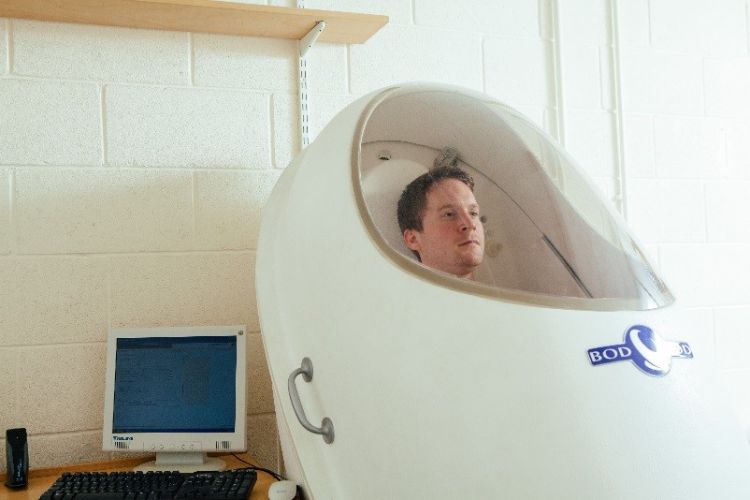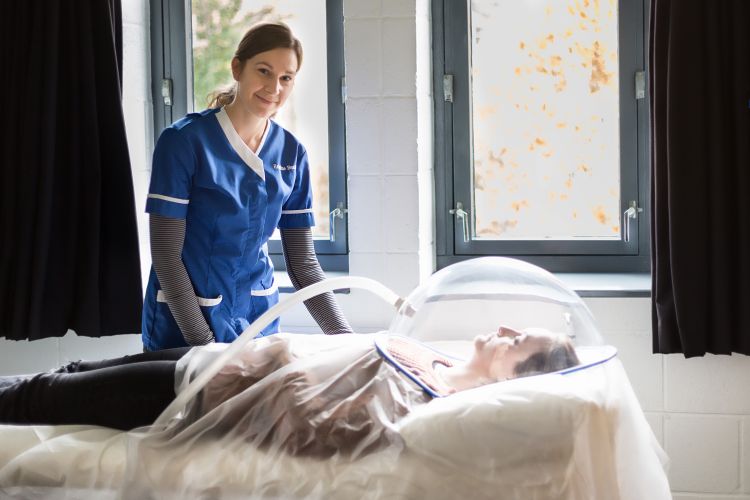Investigating human nutrition
- Overview: The Human Appetite Research Unit features a range of world-leading facilities and resources which enable the innovative research work of its groups – Appetite Control and Energy Balance Group, Nutrition and Behaviour Group and Infant Feeding Group.
iDXA
The iDXA is used for finding out bone mineral density and body composition. It allows for the measurement of amounts of fat and fat free mass that individuals have; but also the distribution of fat. Fat held around the midriff is thought to be more harmful for health therefore we explore this parameter in some of our studies.
Main Contact: Dr Catherine Gibbons
Bodpod

A quick and efficient measurement of body composition with each measure taking under 10 minutes. The measurement technique is air displacement plethysmography and results in working out the amount of fat and fat free mass an individual has.
Main Contact: Dr Catherine Gibbons
Bioelectrical impedance for body composition
Our third technique for measuring body composition – this technique is quick, easy and very cost effective. It is more often used in student dissertations.
Main Contact: Dr Catherine Gibbons
Blood pressure and resting heart rate measurement techniques
Digital monitors for measuring health parameters.
Main Contact: Mrs Fiona Croden
Two clinical kitchens for preparation of test meals
Complete with large amount of storage, plus fridges / freezers / microwaves and cookers. Food for all studies are prepared under strict food safety parameters and are weighed pre and post consumption to measure energy intake.
Main Contact: Mrs Fiona Croden
9 testing cubicles
Our testing cubicles are used in appetite and cognitive studies to ensure participants are influenced by their surroundings / other people
Main Contact: Mrs Fiona Croden
Exercise laboratory – Small Gym
We have a small gym with various pieces of aerobic equipment (treadmills, exercise bikes, cross trainers, rowers). We also have showers / towels available to make participation in studies as easy as possible.
Main Contacts: Dr Graham Finlayson / Dr Catherine Gibbons
Fitness testing equipment – Vmax Encore, Heart rate monitors
Our fitness testing equipment tracks physical exercise sessions and measures cardiovascular fitness.
Main Contact: Dr Catherine Gibbons
Physical Activity devices – wearable technology to measure physical activity, sedentary behaviour and posture
Our physical activity devices measure free living physical activity. We often combine use of several devices. For example, those that are very good at measuring physical activity and those that are very good at measuring posture (so we can quantify time spent sitting down).
Main Contacts: Dr Graham Finlayson / Dr Catherine Gibbons
Gas Exchange Monitors to measure resting energy expenditure
Resting metabolic rate contributes to determining how much food we eat. Therefore we often measure this and provide food individuals with food relative to their own requirements.

Main Contacts: Dr Graham Finlayson / Dr Catherine Gibbons
Handheld devices to measure subjective appetite ratings
We use personal digital assistants with a programme we developed in-house that has the potential to measure numerous questions related to appetite – hunger, fullness and so on.
Main Contact: Dr Catherine Gibbons
Biochemistry room
This enables blood samples to be taken, processed and stored in –80 degree freezer. We can measure HBA1c and glucose in-house. We have a bespoke clinical testing room where trained researchers can take blood samples using venepuncture or cannulation techniques. We can then centrifuge the samples to separate the blood plasma for later analysis.
Main Contact: Dr Catherine Gibbons
Social eating room
Some researchers have an interest in the impact of eating in social settings, so we have a room available where multiple people can eat together.
Main Contact: Mrs Fiona Croden
Eating behaviour trait characteristic questionnaires
We have the capacity and expertise to employ a large range of questionnaires regarding appetite, eating behaviour, psychological wellbeing and so on.
Main Contact: Dr Graham Finlayson / Dr Catherine Gibbons

